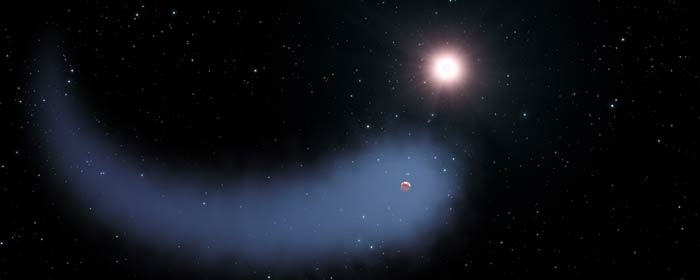The enormous gaseous tail of the planet is about 50 times the size of the parent star. A phenomenon this large has never before been seen around such a small exoplanet.
"Although the evaporation rate doesn't threaten the planet right now, we know that the star, a faint red dwarf, was more active in the past. This means that the planet's atmosphere evaporated faster during its first billion years of existence. Overall, we estimate that it may have lost up to 10 percent of its atmosphere," says David Ehrenreich of the Observatory of the University of Geneva in Switzerland, lead author of the study. Gliese 436b is considered to be a "warm Neptune", because it is similar in size to Neptune, but much closer to its star Gliese 436 than Neptune is to the Sun.

Credit: ESA
Although in this case the planet is in no danger of having its atmosphere completely stripped away — leaving just a solid, rocky core — this behavior could explain the existence of hot super-Earths, which orbit very close to their stars and are typically more massive than Earth, although smaller than the seventeen Earth masses of Neptune.
Hot super-Earths could be the remaining cores of more massive planets that have completely lost their thick, gaseous atmospheres to the same type of evaporation that Hubble observed around Gliese 436b.As the Earth's atmosphere blocks most ultraviolet light, astronomers needed a space telescope with Hubble's ultraviolet capability and exquisite precision to view the cloud. "You wouldn't be able to see it at visible wavelengths," says Ehrenreich. "But when you turn the ultraviolet eye of Hubble onto the system, it's really quite a transformation — the planet turns into a monstrous thing."
Ehrenreich and his team suggest that such a huge cloud of gas can exist around this planet because the cloud is not rapidly heated and swept away by the radiation from the relatively cool red dwarf star. This allows the cloud to stick around for a longer time.Evaporation such as this may also have happened in the earlier history of the Solar System, when the Earth had a hydrogen-rich atmosphere that dissipated. It is also possible that it could happen to Earth's atmosphere at the end of our planet's life, when the Sun swells up to become a red giant and boils off our remaining atmosphere, before engulfing our planet completely.
This animation shows an artistic impression of the transit of Gliese 436b in front of its host star. The planet itself is surrounded by a large halo and is followed by a long comet-like tail. The diagram at the bottom shows the measured brightness of the star as the planet and the cloud of hydrogen it is embedded into moves between the observing astronomers on Earth and the star.Credit:NASA, ESA, STScI, Martin Kornmesser (ESA/Hubble)
At the very youngest, this exoplanet is at least 6 billion years old, but astronomers suspect that it is somewhat older. About the size of Neptune, it has a mass of around 23 Earths. At just 30 light-years from Earth, it is one of the closest known exoplanets."Finding the cloud around Gliese 436b could be a game-changer for characterising atmospheres of the whole population of Neptunes and Super-Earths in ultraviolet observations," explains Vincent Bourrier, also of the Observatory of the University of Geneva in Switzerland and co-author of the study. In the coming years, Bourrier expects that astronomers will find thousands of this kind of planet.
Published in Nature.





Comments